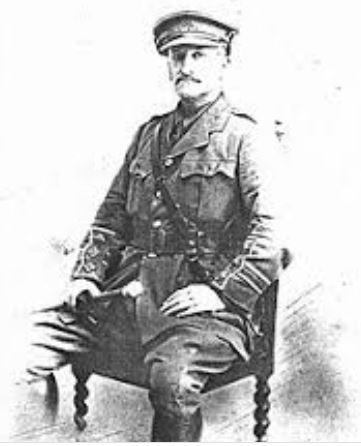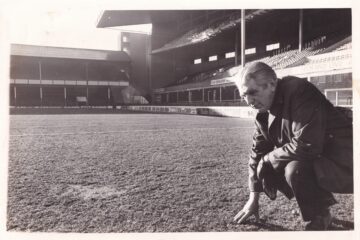There was a larger than usual crowd of journalists filling the Anfield Press Stand when the Everton players took to field on 7 January 1888 to play Notts Rangers. They were there to record what side the club executive would place on the field following the one-month suspension incurred for paying players they had imported from north of the border. The Scots had now departed so they were obliged to fill the vacant positions with local amateur players who were eligible for selection. One of them, John Arthur Eyton-Jones, had been born in1863 at Wrexham in North Wales.
The 1871 census recorded that Thomas Eyton-Jones was living with his wife Sarah at Priory Street in Wrexham where they were waited upon by five servants. They had three sons – Thomas, John and Hugh – who attended the local Grove Park School.

1871 census
On 8 October 1880, the name of JA Eyton-Jones appeared for Saffron Waldron Town in an FA Cup tie at the Oval Cricket Ground in London. Outclassed by the Old Carthusians, they were beaten 7-0. The 1881 census revealed that John was living in this Essex town and was a medical pupil under the instruction of Dr Henry Stear. The following year he returned to the family home and continued his training at Birkenhead Hospital.
Arthur, as he was more commonly known, joined the Hare and Hounds Athletic Club and, along with his brother Thomas, played association football for them during the winter months. On 17 March 1883, while on the register with this club, he won his first international cap when he represented Wales as they played out a 1-1 draw, with Ireland in Belfast. The following season, Arthur signed for Bootle and took part in the inaugural game of football on the Hawthorne Road Cricket Ground. Their opponents, Aston Villa, were leading 1-0 when Arthur scored to bring the sides level. The visitors, however, disputed the goal so the referee, taking in to account the torrential downpour, decided to terminate the game.
On 13 January 1884, Arthur joined the 1st Volunteer Brigade, Royal Welsh Fusiliers and was granted the rank of Surgeon-Lieutenant. He resigned his commission one year later.
The Welshman continued to appear in the Bootle side throughout the season and was occasionally joined by his elder brother, Thomas. The next season he appeared again in the Bootle colours and encountered their neighbours Everton for the first time.
The game took place 1 November 1884 at Hawthorne Road where the visitors won 2-1. Arthur made his first appearance at Anfield on 31 January – when Bootle and Everton met in the Liverpool Cup – where the home side won by three goals to one. He then took part in all three of the home internationals.
In terms of his appearances for Wales, he scored his only international goal on 9 February 1884 as Wales beat Ireland 6-0 on the Racecourse Ground at Wrexham. He returned to same venue on 17 March but could do little to prevent England from running out winners, 4-0. Arthur Eyton-Jones made his fourth and final appearance for his country two weeks later in a 4-1 defeat by Scotland at Cathkin Park in Glasgow. The Welsh FA, however, still held his registration so he always appeared in the newspapers when representing Wexham.
The 1885-86 campaign proved to be the last full season Arthur would spend with Bootle as they battled for local supremacy with Everton. His side lost their home game against them 2-1, but managed a 2-2 draw in the return fixture at Anfield. The two sides met, however, in the final tie of the Liverpool Cup at Walton Stiles. The game was won by Everton courtesy of a single goal scored by Welsh International, Job Wilding.
The following season, after an absence of four years, Bootle entered the FA Cup and received a home draw against the Bolton-based side, Great Lever. Arthur made his final appearance for Bootle as they were beaten by four goals to two. He was then reported to have gone in to ‘semi-retirement’ before his reappearance at Anfield in January 1888.
The Everton committee met on the Friday evening prior to the Notts Rangers game to discuss what team they could assemble and released the names of ten players plus A N Other who turned out to be Arthur. The start of the game was delayed by the late arrival of the home team who played part of the first half with ten men. The visitors won the game by three goals to one. Arthur made another thirteen appearances for Everton, the last one being against Bolton Wanderers. He then retired from the game. The next year he qualified as a doctor and set up a practice at 78, High Street, Gringley on the Hill in Nottinghamshire.

J.A. Eyton-Jones – final appearance – Everton 1 v 2 Bolton Wanderers, Anfield, 2 April 1888 (Everton Collection)
On 28 July 1891, JA Eyton-Jones married Scotswoman Annie Stodart–Milne at the church of St Phillip in London and his only child, Margaret, was born two years later. In 1895 the family moved back to Wrexham where they occupied a fine house, Abbotsford, in Grosvenor Road in the centre of town. Annie died here in 1908. The 1911 census revealed that Arthur had remarried and was practising from his home at 66, Union Street West, in the Lancashire town of Oldham. He was assisted by his daughter.


Grosvenor Road, Wrexham.
J.A Eyton-Jones lived in the house on the left. The road is still a centre for health and medical institutions to this day.
In March 1915, Arthur joined the Royal Army Medical Corps and was attached to the Welsh Border Mounted Brigade Field Ambulance. He was granted the rank of Captain and awarded a Silver Medal at the end of his service. At that time, the family were living at a house named Abbeydale, in the Gresford area of Wrexham. They later moved to Mount Road, Higher Tranmere, Birkenhead where the head of the household became a surgeon at the Liverpool Royal Infirmary. John Arthur Eyton-Jones was residing at this address when he died on 2 March 1948. The funeral service took place at the church of St Paul before interment at Wrexham Cemetery.

Captain J.A Eyton-Jones
Royal Army Medical Corps, attached to the Welsh Border Mounted Brigade Field Ambulance

Wrexham Cemetery
(photo: Kevin Laroux Wood)
Edited by Francis Hickey
Document/photo research by Mike Royden



